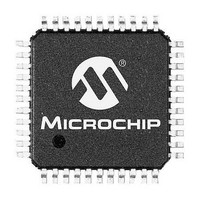DSPIC33FJ128GP804-H/PT Microchip Technology, DSPIC33FJ128GP804-H/PT Datasheet - Page 70

DSPIC33FJ128GP804-H/PT
Manufacturer Part Number
DSPIC33FJ128GP804-H/PT
Description
16-bit DSC, 128KB Flash, CAN, DMA, 40 MIPS, NanoWatt 44 TQFP 10x10x1mm TRAY
Manufacturer
Microchip Technology
Series
dsPIC™ 33Fr
Datasheet
1.DSPIC33FJ32GP302-ISO.pdf
(412 pages)
Specifications of DSPIC33FJ128GP804-H/PT
Core Processor
dsPIC
Core Size
16-Bit
Speed
40 MIPs
Connectivity
CAN, I²C, IrDA, LIN, SPI, UART/USART
Peripherals
AC'97, Brown-out Detect/Reset, DMA, I²S, POR, PWM, WDT
Number Of I /o
35
Program Memory Size
128KB (128K x 8)
Program Memory Type
FLASH
Ram Size
16K x 8
Voltage - Supply (vcc/vdd)
3 V ~ 3.6 V
Data Converters
A/D 13x10b/12b, D/A 6x16b
Oscillator Type
Internal
Operating Temperature
-40°C ~ 140°C
Package / Case
44-TQFP
Processor Series
dsPIC33F
Core
dsPIC
Data Bus Width
16 bit
Interface Type
SPI, I2C, UART, JTAG
Number Of Programmable I/os
35
Operating Supply Voltage
3.3 V
Maximum Operating Temperature
+ 140 C
Mounting Style
SMD/SMT
Development Tools By Supplier
MPLAB IDE Software
Minimum Operating Temperature
- 40 C
On-chip Adc
10 bit, 13 Channel
A/d Bit Size
10 bit
A/d Channels Available
13
Lead Free Status / RoHS Status
Lead free / RoHS Compliant
Eeprom Size
-
Lead Free Status / Rohs Status
Details
Available stocks
Company
Part Number
Manufacturer
Quantity
Price
Company:
Part Number:
DSPIC33FJ128GP804-H/PT
Manufacturer:
Microchip Technology
Quantity:
10 000
- Current page: 70 of 412
- Download datasheet (6Mb)
dsPIC33FJ32GP302/304, dsPIC33FJ64GPX02/X04, AND dsPIC33FJ128GPX02/X04
4.6.2
The TBLRDL and TBLWTL instructions offer a direct
method of reading or writing the lower word of any
address within the program space without going
through data space. The TBLRDH and TBLWTH
instructions are the only method to read or write the
upper 8 bits of a program space word as data.
The PC is incremented by two for each successive
24-bit program word. This allows program memory
addresses to directly map to data space addresses.
Program memory can thus be regarded as two 16-bit-
wide word address spaces, residing side by side, each
with the same address range. TBLRDL and TBLWTL
access the space that contains the least significant
data word. TBLRDH and TBLWTH access the space that
contains the upper data byte.
Two table instructions are provided to move byte or
word-sized (16-bit) data to and from program space.
Both function as either byte or word operations.
• TBLRDL (Table Read Low):
FIGURE 4-10:
DS70292E-page 70
- In Word mode, this instruction maps the
lower word of the program space
location (P<15:0>) to a data address
(D<15:0>).
TBLPAG
02
DATA ACCESS FROM PROGRAM
MEMORY USING TABLE
INSTRUCTIONS
23
ACCESSING PROGRAM MEMORY WITH TABLE INSTRUCTIONS
15
0
0x000000
0x020000
0x030000
0x800000
Program Space
The address for the table operation is determined by the data EA
within the page defined by the TBLPAG register.
Only read operations are shown; write operations are also valid in
the user memory area.
TBLRDH.B
TBLRDL.B
TBLRDL.B
TBLRDL.W
• TBLRDH (Table Read High):
In a similar fashion, two table instructions, TBLWTH
and TBLWTL, are used to write individual bytes or
words to a program space address. The details of
their operation are explained in
Program
For all table operations, the area of program memory
space to be accessed is determined by the Table Page
register (TBLPAG). TBLPAG covers the entire program
memory space of the device, including user application
and configuration spaces. When TBLPAG<7> = 0, the
table page is located in the user memory space. When
TBLPAG<7> = 1, the page is located in configuration
space.
‘Phantom’ Byte
- In Byte mode, either the upper or lower byte
- In Word mode, this instruction maps the entire
- In Byte mode, this instruction maps the upper
00000000
00000000
00000000
00000000
of the lower program word is mapped to the
lower byte of a data address. The upper byte
is selected when Byte Select is ‘1’; the lower
byte is selected when it is ‘0’.
upper word of a program address (P<23:16>)
to a data address. The ‘phantom’ byte
(D<15:8>), is always ‘0’.
or lower byte of the program word to D<7:0>
of the data address, in the TBLRDL instruc-
tion. The data is always ‘0’ when the upper
‘phantom’ byte is selected (Byte Select = 1).
(Wn<0> = 0)
(Wn<0> = 1)
(Wn<0> = 0)
Memory”.
23
16
© 2011 Microchip Technology Inc.
Section 5.0 “Flash
8
0
Related parts for DSPIC33FJ128GP804-H/PT
Image
Part Number
Description
Manufacturer
Datasheet
Request
R

Part Number:
Description:
Manufacturer:
Microchip Technology Inc.
Datasheet:

Part Number:
Description:
Manufacturer:
Microchip Technology Inc.
Datasheet:

Part Number:
Description:
Manufacturer:
Microchip Technology Inc.
Datasheet:

Part Number:
Description:
Manufacturer:
Microchip Technology Inc.
Datasheet:

Part Number:
Description:
Manufacturer:
Microchip Technology Inc.
Datasheet:

Part Number:
Description:
Manufacturer:
Microchip Technology Inc.
Datasheet:

Part Number:
Description:
Manufacturer:
Microchip Technology Inc.
Datasheet:

Part Number:
Description:
Manufacturer:
Microchip Technology Inc.
Datasheet:











